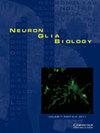Armin Kraus, Joachim Täger, Konrad Kohler, Max Haerle, Frank Werdin, Hans-Eberhard Schaller, Nektarios Sinis
{"title":"用FuGENE HD©脂质转染和AMAXA©核转染对大鼠雪旺细胞进行非病毒遗传转染是可行的,但会损害细胞活力。","authors":"Armin Kraus, Joachim Täger, Konrad Kohler, Max Haerle, Frank Werdin, Hans-Eberhard Schaller, Nektarios Sinis","doi":"10.1017/S1740925X11000056","DOIUrl":null,"url":null,"abstract":"<p><strong>Purpose: </strong>To determine transfection efficiency of FuGENE HD© lipofection and AMAXA© nucleofection on rat Schwann cells (SC).</p><p><strong>Methods: </strong>The ischiadic and median nerves of 6-8 week old Lewis rats were cultured in modified melanocyte-growth medium. SCs were genetically transfected with green fluorescent protein (GFP) as reporter gene using FuGENE HD© lipofection and AMAXA© nucleofection. Transfection rates were determined by visualization of GFP fluorescence under fluorescence microscopy and cell counting. Transfected cell to non-transfected cell relation was determined.</p><p><strong>Results: </strong>Purity of Schwann cell culture was 88% as determined by immunohistologic staining. Transfection rate of FuGENE HD© lipofection was 2%, transfection rate of AMAXA© nucleofection was 10%. With both methods, Schwann cells showed pronounced aggregation behavior which made them unfeasible for further cultivation. Settling of Schwann cells on laminin and poly-L-ornithine coated plates was compromised by either method.</p><p><strong>Conclusion: </strong>Non-viral transfection of rat SC with FuGENE HD© lipofection and AMAXA© nucleofection is basically possible with a higher transfection rate for nucleofection than for lipofection. As cell viability is compromised by either method however, viral transfection is to be considered if higher efficiency is required.</p>","PeriodicalId":19153,"journal":{"name":"Neuron glia biology","volume":"6 4","pages":"225-30"},"PeriodicalIF":0.0000,"publicationDate":"2010-11-01","publicationTypes":"Journal Article","fieldsOfStudy":null,"isOpenAccess":false,"openAccessPdf":"https://sci-hub-pdf.com/10.1017/S1740925X11000056","citationCount":"9","resultStr":"{\"title\":\"Non-viral genetic transfection of rat Schwann cells with FuGENE HD© lipofection and AMAXA© nucleofection is feasible but impairs cell viability.\",\"authors\":\"Armin Kraus, Joachim Täger, Konrad Kohler, Max Haerle, Frank Werdin, Hans-Eberhard Schaller, Nektarios Sinis\",\"doi\":\"10.1017/S1740925X11000056\",\"DOIUrl\":null,\"url\":null,\"abstract\":\"<p><strong>Purpose: </strong>To determine transfection efficiency of FuGENE HD© lipofection and AMAXA© nucleofection on rat Schwann cells (SC).</p><p><strong>Methods: </strong>The ischiadic and median nerves of 6-8 week old Lewis rats were cultured in modified melanocyte-growth medium. SCs were genetically transfected with green fluorescent protein (GFP) as reporter gene using FuGENE HD© lipofection and AMAXA© nucleofection. Transfection rates were determined by visualization of GFP fluorescence under fluorescence microscopy and cell counting. Transfected cell to non-transfected cell relation was determined.</p><p><strong>Results: </strong>Purity of Schwann cell culture was 88% as determined by immunohistologic staining. Transfection rate of FuGENE HD© lipofection was 2%, transfection rate of AMAXA© nucleofection was 10%. With both methods, Schwann cells showed pronounced aggregation behavior which made them unfeasible for further cultivation. Settling of Schwann cells on laminin and poly-L-ornithine coated plates was compromised by either method.</p><p><strong>Conclusion: </strong>Non-viral transfection of rat SC with FuGENE HD© lipofection and AMAXA© nucleofection is basically possible with a higher transfection rate for nucleofection than for lipofection. As cell viability is compromised by either method however, viral transfection is to be considered if higher efficiency is required.</p>\",\"PeriodicalId\":19153,\"journal\":{\"name\":\"Neuron glia biology\",\"volume\":\"6 4\",\"pages\":\"225-30\"},\"PeriodicalIF\":0.0000,\"publicationDate\":\"2010-11-01\",\"publicationTypes\":\"Journal Article\",\"fieldsOfStudy\":null,\"isOpenAccess\":false,\"openAccessPdf\":\"https://sci-hub-pdf.com/10.1017/S1740925X11000056\",\"citationCount\":\"9\",\"resultStr\":null,\"platform\":\"Semanticscholar\",\"paperid\":null,\"PeriodicalName\":\"Neuron glia biology\",\"FirstCategoryId\":\"1085\",\"ListUrlMain\":\"https://doi.org/10.1017/S1740925X11000056\",\"RegionNum\":0,\"RegionCategory\":null,\"ArticlePicture\":[],\"TitleCN\":null,\"AbstractTextCN\":null,\"PMCID\":null,\"EPubDate\":\"2011/6/7 0:00:00\",\"PubModel\":\"Epub\",\"JCR\":\"\",\"JCRName\":\"\",\"Score\":null,\"Total\":0}","platform":"Semanticscholar","paperid":null,"PeriodicalName":"Neuron glia biology","FirstCategoryId":"1085","ListUrlMain":"https://doi.org/10.1017/S1740925X11000056","RegionNum":0,"RegionCategory":null,"ArticlePicture":[],"TitleCN":null,"AbstractTextCN":null,"PMCID":null,"EPubDate":"2011/6/7 0:00:00","PubModel":"Epub","JCR":"","JCRName":"","Score":null,"Total":0}
引用次数: 9

 求助内容:
求助内容: 应助结果提醒方式:
应助结果提醒方式:


